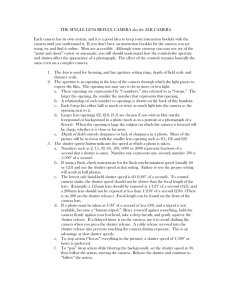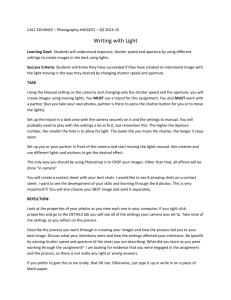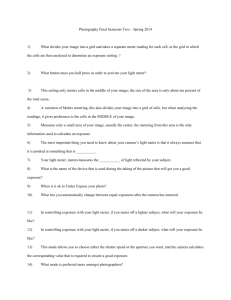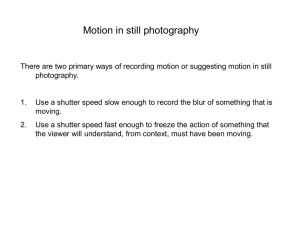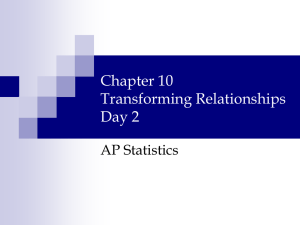study guide - Photojournalism
advertisement
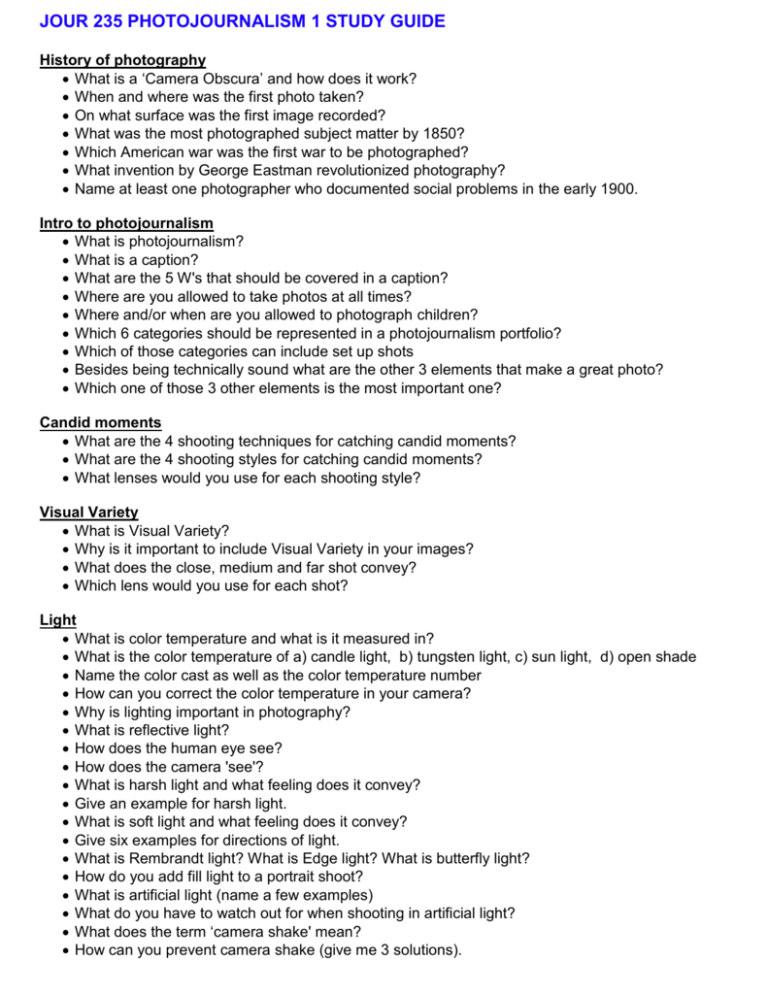
JOUR 235 PHOTOJOURNALISM 1 STUDY GUIDE History of photography What is a ‘Camera Obscura’ and how does it work? When and where was the first photo taken? On what surface was the first image recorded? What was the most photographed subject matter by 1850? Which American war was the first war to be photographed? What invention by George Eastman revolutionized photography? Name at least one photographer who documented social problems in the early 1900. Intro to photojournalism What is photojournalism? What is a caption? What are the 5 W's that should be covered in a caption? Where are you allowed to take photos at all times? Where and/or when are you allowed to photograph children? Which 6 categories should be represented in a photojournalism portfolio? Which of those categories can include set up shots Besides being technically sound what are the other 3 elements that make a great photo? Which one of those 3 other elements is the most important one? Candid moments What are the 4 shooting techniques for catching candid moments? What are the 4 shooting styles for catching candid moments? What lenses would you use for each shooting style? Visual Variety What is Visual Variety? Why is it important to include Visual Variety in your images? What does the close, medium and far shot convey? Which lens would you use for each shot? Light What is color temperature and what is it measured in? What is the color temperature of a) candle light, b) tungsten light, c) sun light, d) open shade Name the color cast as well as the color temperature number How can you correct the color temperature in your camera? Why is lighting important in photography? What is reflective light? How does the human eye see? How does the camera 'see'? What is harsh light and what feeling does it convey? Give an example for harsh light. What is soft light and what feeling does it convey? Give six examples for directions of light. What is Rembrandt light? What is Edge light? What is butterfly light? How do you add fill light to a portrait shoot? What is artificial light (name a few examples) What do you have to watch out for when shooting in artificial light? What does the term ‘camera shake' mean? How can you prevent camera shake (give me 3 solutions). Ethics Can you believe today's photos? Where do you expect unaltered and non-setup photos to occur? What are the consequences when a professional photographer alters an image? What would you do if you would ever face an ethical dilemma? Technical camera basics 1 What's the difference between a digital point and shoot and a digital SLR camera? How can you find out if you have a digital SLR or a point and shoot camera? What does SLR stand for? Why is it a good idea to buy a UV lens filter and a lens hood for a digital SLR camera? Where is the shutter located and what does it do? Where is the aperture located and what does it do? What does the term 'image quality' mean in your camera's menu setting? What is the difference between shooting a RAW file and shooting a JEPEG file? What is the chip inside your camera called which initially records the image? What is the card inside your camera called that the image gets downloaded/stored onto ? When and why is it important to reformat your memory card? When and why do you need to turn off the power of your camera? Technical camera basics 2 How do the shooting modes AUTO and PROGRAM work? What is ISO? Which ISO setting do you choose for a sunny day outdoors? What is a fixed lens and what is a zoom lens? What is the zoom range of your lens? What do these focal lengths mean: wide angle, normal and telephoto? What is white balance and how do you set it? How does the camera tell you that your images are in focus? How do you set focus lock and why/when would you use this function? How do you set focus tracking and why/when would you use this function? White balance in depth What is white balance and why do you need to set your camera to correct WB? What options of white balance settings does your camera offer? What color cast does daylight have in open shade? What color cast does candle light have at night? What are Kelvins? What can you tell me about a situations that measures 5000 Kelvins? What can you tell me about a situations that measures 1000 Kelvins? What can you tell me about a situations that measures 8000 Kelvins? What white balance symbol would set your white balance to when photographing on a foggy day? Shutter/Motion What does TV/S stand for? How does this mode setting work? When is it a good idea to use the TV/S setting? Where is the shutter located? Which 2 things does the shutter control? What is you camera's fastest and slowest shutter speed? What shutter speed setting gives you the least amount of motion in your images? What shutter speed setting gives you the most amount of motion in your images? What does 'bulb' stand for? What are your camera's shutter speeds in full stop increments when you start at 1 second? What does the term 'one stop' mean? If you use a 1/1000 sec shutter speed and I ask you to slow down the shutter speed by 1 stop. What's the new shutter speed? If your shutter speed is set at 1/60 sec and I ask you to speed it up 1 stop, what would your new shutter speed be? Name 3 different types of motion capturing techniques. Describe how to execute them and what they will look like. What is camera shake and how do you prevent it? What are the 3 factors that influence motion? What does single frame vs. consecutive frame shooting mean? What is the best lens to cover a foot ball game? What is the slowest shutter speed you can hold a 200 mm lens with? What is image stabilization? You are using a 200 mmm lens that has image stabilization. It is a known fact that you can hand hold that lens at a shutter speed that is 3 stops slower than without the stabilization. What is the slowest shutter speed you can hand hold this lens with? During which motion capturing technique do you need to switch OFF image stabilization? You are photographing a track and field event. You decide to shoot a stop motion shot at 1/500sec. You would like to do a blur motion shot. Which shutter speed would you use? Now you decide to do a pan shoot. Which shutter speed will you select to execute this pan shot? You set the shutter speed at 1/1000 sec shutter speed and I ask you to slow down the shutter speed by 1 stop. What is the new shutter speed? What does the term 'one stop' mean? You are shooting a basketball game in lo light. You are already at ISO 1600 and you can only set a 1/60 sec shutter speed. What can you do to get a stop action shot of a player? (give me 2 solutions) How do you over/under expose your image on the TV/S setting? If you are on 1/125 sec and I ask you to under expose your image by one stop-what is the new shutter sped? Lenses and Focusing What is a fixed lens and what is a zoom lens? Is a fixed lens the same as a prime lens? What is the advantage of a fixed/prime lens? What is the advantage of a zoom lens? What is the zoom range of your lens? What do these focal lengths mean: wide angle, normal and telephoto? Why do you need a UV filter and a lens hood for your camera? What's the difference between AF an MF? When and why do you want to switch to manual focus? What is the plane of critical focus? What is focus tracking and how do you set it? What does focus lock accomplish and how to you set it? Which focal length would you use to photograph a flower? Aperture/Depth of Field What does A (Av) stand for? How does it work? When is it a good idea to use the A (Av) setting? Where is the aperture located? Which 2 things does the aperture control? What is the depth of field? How do you obtain shallow depth of field? How do you obtain great depth of field? When do you use shallow and when do you use great depth of field in your photos? How far does the depth of field reach in front and behind the plane of critical focus? What are the 3 factors that influence depth of field? Here are some aperture settings in 1stop increments: f2.8, f4, f5.6, f8, f11, f16, f22 What is the relation ship between f4 and f5.6? Does f8 let in double as much light as f11? Does f11 let in four times as much light as f16? If you use f16 and I ask you to 'open up' your aperture by one stop, what is the new aperture setting? How do you over/under expose your image on the Av (A) setting? If you are on aperture setting f4 and I ask you to under expose your image by one stop-what is the new aperture setting? Exposure in depth What type of light meter is inside your camera? What does an over/under exposed image look like? How do you expose for a white snowman on a snowfield? What does 18% grey refer to in photography? Exposure problems to solve The settings are given in FULL STOP increments: APERTURE OPENINGS: f2.8 f4 f5.6 f8 f11 f16 f22 SHUTTER SPEEDS: 1sec, 1/2sec 1/4sec 1/8sec 1/15sec, 1/30sec, 1/60sec, 1/125sec 1/250sec, 1/500sec, 1/1000sec, 1/2000sec, 1/4000sec ISO SETTINGS: 100 ISO, 200 ISO, 400 ISO, 800 ISO 1600 ISO 1)The correct exposure is f/8@ 1/125 sec. You decide to use shallower depth of field and switch to f5.6. What is the new shutter speed? 2) The correct exposure is f/8@ 1/125 sec. You decide to do a pan shot. What is the exposure setting? 3) You are shooting with a 200 mm lens without a tripod. You don’t have an image stabilizer. What is the slowest shutter speed that you can hand hold this lens with? 4) You are shooting a subject walking by you, across a field from left to right. Your ISO is set at 100 and your exposure is 1/60 sec at f 2.8. What does the shot look like? 5) You are shooting a subject walking towards you and your camera. Your ISO is set at 100 and your exposure is 1/60 sec at f 2.8. What does the shot look like? 6)The correct exposure reads f/16 @ 1/500 sec. You decide to over expose by one stop. What is the new exposure setting? 7) The correct exposure reads f/5,6@ 1/1000 sec at 400 ISO You decide to under expose by 2 stop. What is the new exposure setting? Computer basics 1 Why is it important to use a card reader to down load your images? Why should you never open up your images from the flash card in your card reader? Why do you need to immediately back up your downloaded images? How do you sign onto the computer lab server? How do you view your images in Photo Mechanic? How do you rename your image? How do you move your image into a new folder? How do you copy your image into a new folder? Why do you want to avoid repeatedly saving the same file in Jpeg format?

